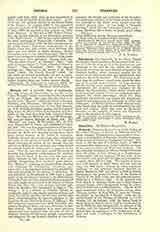

Diakovar (Croatian, Djakovo), see of the Bishop of the united Dioceses of Bosnia or Diakovar and Sirmium (Szerem) (Bosniensis seu Diacovensis et Sirmiensis), a municipality of Slavonia (Austria-Hungary), in the county of Virovititz (Hungarian Verocze). Diakovar is also the seat of a district court; in 1900 it contained 6824 inhabitants, mostly Catholics, of whom 65 per cent were Serbs and 28 per cent Germans. The fine cathedral, completed in 1883 by Friedrich Schmidt from the plans of Karl Rosner, is a Romanesque-Gothic edifice, 256 feet long and 197 feet wide; it has two towers, each about 276 feet high, and, in addition, a cupola about 203 feet high. The interior is decorated with frescoes by Seitz, father and son, and the organ has 3000 pipes. Among the other important buildings are the episcopal seminary founded by Bishop Mandi6 in 1807 and altered in 1858 by Bishop Strossmayer, the provincial house of the Sisters of Charity of the Holy Cross, and the episcopal palace. Diakovar is of Roman origin. On the imperial road from Sissek to Sirmium there was a large station named Certissa, which disappeared during the migrations of the fourth and fifth centuries. The site is not again mentioned before the thirteenth century, when Coloman, brother of King Bela IV, gave the “Possessio Diaco” to the Bishop of Bosnia. After the reestablishment of the Diocese of Sirmium (q.v.) by Gregory IX, January 20, 1229, the bishop lived at Bosna Seraj in Bosnia, but in 1246 he transferred his see to Diakovar after Gregory IX, on account of the troubles with the Bogomili, withdrew the Diocese of Bosnia from its subjection to the Archdiocese of Ragusa and made it suffragan to the Archdiocese of Kalocsa.
In 1735 the territory of the Diocese of Bosnia became the Vicariate Apostolic of Bosnia and Herzegovina (q.v.), while by a Bull of Clement XIV of July 9, 1773, the See of Sirmium was united in perpetuity with Diakovar. Since this date the Bishops of Diakovar have borne the title “of Bosnia, or Diakovar and Sirmium”. Since 1852 the diocese has been a suffragan of Agram (Zagrab), which was founded in that year.
Among the most important medieval bishops of Diakovar were Blessed Johannes Teutonicus (1233-41) who died in 1253 as fourth Master General of the Dominican Order, and the Franciscan Blessed Peregrinus (1349-56). In the nineteenth century Bishop Joseph Georg Strossmayer (q.v.) exceeded all his predecessors, not only in the length of his episcopate (1849-1905), but also in the fruitful results of his labors for his diocese, especially as a patron of art and learning. After his death the see was administered by the vicar capitular, Dr. Engelbert Vorgak. The cathedral chapter, established in 1239, disappeared after the invasion of the Turks in 1453. It was restored in 1773 by Maria Teresa and it consists of 8 regular and 6 honorary canons. Since 1881 the diocese is limited to the Croatian-Slavonian counties of Verovititz (Verocze), Szerem, and Pozhega, and includes, according to the statistics for 1908: 4 archdeaconries; 11 vice-archdeaconries; 90 parishes with 376 dependent chapels and stations, and 4 expositures; 174 secular and regular priests; 294,674 Catholics and 6205 Uniat Greeks in a total population of 515,897. The male religious orders in the diocese are: Franciscans, 6 monasteries; Capuchins, 1 monastery in Esseg (Eszek or Osjek) with 6 religious. The female communities include 37 Sisters of Charity of St. Vincent de Paul, and 39 Sisters of Charity of the Holy Cross. Besides the seminary for priests at Diakovar, mentioned above, there is a seminary for boys at Esseg established by Bishop Strossmayer in 1899. The most celebrated place of pilgrimage in the Diocese of Diakovar is Mariaschnee near Peterwardein. The patron saint for Diakovar is St. Elias, for Szerem, St. Demetrius.
GREGOR REINHOLD

